I'm working on a design in Vivado. My top level design is a block diagram. The block diagram has IP blocks and my Verilog RTL modules. Whenever I change my main module and Verilog updates the block diagram, it always incorrectly infers the clock frequency for my module. How can I fix this?
This issue is infuriating, ask it breaks my design. All of the other AXI busses in the design are correctly using 10MHz, but whenever I change main and the block diagram is updated, Vivado decides main's AXI busses are at 100MHz. And as long as the clocks are mismatched, I can't build. I can manually update the frequency in the properties for the block in the block diagram, but those changes are wiped every time I update main (which is frequently, because it's my main module).
I've tried adding a dedicated clock and reset for each AXI bus (even though they all connect to the same net). I've messed around with X_INTERFACE_PARAMETER (is this documented anywhere?). All to no avail.
Also, M_AXIS_CMD is a master AXI interface and should be on the output side of the block for main. Not sure what's up with that. But that's a pretty minor issue compared to the clock.
Source: https://gitlab.com/tessera/pcd8544-tests
Module interface:
module main #(
CLK_FREQ = 50000000// : CLK_FREQ > 0 // clock frequency
)(
(* X_INTERFACE_PARAMETER = "XIL_INTERFACENAME core_clk, ASSOCIATED_RESET core_rst, FREQ_HZ 10000000" *)
(* X_INTERFACE_INFO = "xilinx.com:signal:clock:1.0 core_clk CLK" *)
input clk,
(* X_INTERFACE_PARAMETER = "XIL_INTERFACENAME core_rst, POLARITY ACTIVE_HIGH" *)
(* X_INTERFACE_INFO = "xilinx.com:signal:reset:1.0 core_rst RST" *)
input rst,
(* X_INTERFACE_PARAMETER = "XIL_INTERFACENAME axi_rst, POLARITY ACTIVE_LOW" *)
(* X_INTERFACE_INFO = "xilinx.com:signal:reset:1.0 axi_rst RST" *)
input axi_rst,
(* X_INTERFACE_INFO = "xilinx.com:interface:fifo_write:1.0 DOUT FULL" *)
input wr_full,
(* X_INTERFACE_INFO = "xilinx.com:interface:fifo_write:1.0 DOUT WR_DATA" *)
output reg [8:0] wr_data,
(* X_INTERFACE_INFO = "xilinx.com:interface:fifo_write:1.0 DOUT WR_EN" *)
output reg wr_valid,
// slave AXI-Lite write channel FROM PS
(* X_INTERFACE_INFO = "xilinx.com:interface:aximm_rtl:1.0 S_AXI_REG AWADDR" *) input wire [4:0] s_axi_reg_awaddr, // address
(* X_INTERFACE_INFO = "xilinx.com:interface:aximm_rtl:1.0 S_AXI_REG AWPROT" *) input wire [2:0] s_axi_reg_awprot, // channel protection type
(* X_INTERFACE_INFO = "xilinx.com:interface:aximm_rtl:1.0 S_AXI_REG AWVALID" *) input wire s_axi_reg_awvalid, // address valid
(* X_INTERFACE_INFO = "xilinx.com:interface:aximm_rtl:1.0 S_AXI_REG AWREADY" *) output wire s_axi_reg_awready, // address ready
(* X_INTERFACE_INFO = "xilinx.com:interface:aximm_rtl:1.0 S_AXI_REG WDATA" *) input wire [31:0] s_axi_reg_wdata, // data
(* X_INTERFACE_INFO = "xilinx.com:interface:aximm_rtl:1.0 S_AXI_REG WSTRB" *) input wire [3:0] s_axi_reg_wstrb, // strobes - one bit per byte of data
(* X_INTERFACE_INFO = "xilinx.com:interface:aximm_rtl:1.0 S_AXI_REG WVALID" *) input wire s_axi_reg_wvalid, // data/strobes valid
(* X_INTERFACE_INFO = "xilinx.com:interface:aximm_rtl:1.0 S_AXI_REG WREADY" *) output wire s_axi_reg_wready, // data/strobes ready
(* X_INTERFACE_INFO = "xilinx.com:interface:aximm_rtl:1.0 S_AXI_REG BRESP" *) output wire [1:0] s_axi_reg_bresp, // response
(* X_INTERFACE_INFO = "xilinx.com:interface:aximm_rtl:1.0 S_AXI_REG BVALID" *) output wire s_axi_reg_bvalid, // response valid
(* X_INTERFACE_INFO = "xilinx.com:interface:aximm_rtl:1.0 S_AXI_REG BREADY" *) input wire s_axi_reg_bready, // response ready
// slave AXI-Lite read channel FROM PS
(* X_INTERFACE_INFO = "xilinx.com:interface:aximm_rtl:1.0 S_AXI_REG ARADDR" *) input wire [4:0] s_axi_reg_araddr, // address
(* X_INTERFACE_INFO = "xilinx.com:interface:aximm_rtl:1.0 S_AXI_REG ARPROT" *) input wire [2:0] s_axi_reg_arprot, // channel protection type
(* X_INTERFACE_INFO = "xilinx.com:interface:aximm_rtl:1.0 S_AXI_REG ARVALID" *) input wire s_axi_reg_arvalid, // address valid
(* X_INTERFACE_INFO = "xilinx.com:interface:aximm_rtl:1.0 S_AXI_REG ARREADY" *) output wire s_axi_reg_arready, // address ready
(* X_INTERFACE_INFO = "xilinx.com:interface:aximm_rtl:1.0 S_AXI_REG RDATA" *) output wire [31:0] s_axi_reg_rdata, // data
(* X_INTERFACE_INFO = "xilinx.com:interface:aximm_rtl:1.0 S_AXI_REG RRESP" *) output wire [1:0] s_axi_reg_rresp, // response
(* X_INTERFACE_INFO = "xilinx.com:interface:aximm_rtl:1.0 S_AXI_REG RVALID" *) output wire s_axi_reg_rvalid, // data/response valid
(* X_INTERFACE_INFO = "xilinx.com:interface:aximm_rtl:1.0 S_AXI_REG RREADY" *) input wire s_axi_reg_rready, // data/response ready
// master AXI-Stream command channel TO DataMover
(* X_INTERFACE_INFO = "xilinx.com:interface:axis_rtl:1.0 M_AXIS_CMD TDATA" *) output reg [71:0] m_axis_cmd_data,
(* X_INTERFACE_INFO = "xilinx.com:interface:axis_rtl:1.0 M_AXIS_CMD TREADY" *) output reg m_axis_cmd_valid,
(* X_INTERFACE_INFO = "xilinx.com:interface:axis_rtl:1.0 M_AXIS_CMD TVALID" *) input wire m_axis_cmd_ready,
// slave AXI-Stream status channel FROM DataMover
(* X_INTERFACE_INFO = "xilinx.com:interface:axis_rtl:1.0 S_AXIS_STS TDATA" *) input wire [7:0] s_axis_status_data,
(* X_INTERFACE_INFO = "xilinx.com:interface:axis_rtl:1.0 S_AXIS_STS TKEEP" *) input wire [0:0] s_axis_status_keep,
(* X_INTERFACE_INFO = "xilinx.com:interface:axis_rtl:1.0 S_AXIS_STS TLAST" *) input wire s_axis_status_last,
(* X_INTERFACE_INFO = "xilinx.com:interface:axis_rtl:1.0 S_AXIS_STS TREADY" *) input wire s_axis_status_valid,
(* X_INTERFACE_INFO = "xilinx.com:interface:axis_rtl:1.0 S_AXIS_STS TVALID" *) output reg s_axis_status_ready,
// slave AXI-Stream data channel FROM DataMover
(* X_INTERFACE_INFO = "xilinx.com:interface:axis_rtl:1.0 S_AXIS_DATA TDATA" *) input wire [31:0] s_axis_stream_data,
(* X_INTERFACE_INFO = "xilinx.com:interface:axis_rtl:1.0 S_AXIS_DATA TKEEP" *) input wire [3:0] s_axis_stream_keep,
(* X_INTERFACE_INFO = "xilinx.com:interface:axis_rtl:1.0 S_AXIS_DATA TLAST" *) input wire s_axis_stream_last,
(* X_INTERFACE_INFO = "xilinx.com:interface:axis_rtl:1.0 S_AXIS_DATA TREADY" *) input wire s_axis_stream_valid,
(* X_INTERFACE_INFO = "xilinx.com:interface:axis_rtl:1.0 S_AXIS_DATA TVALID" *) output reg s_axis_stream_ready,
// DataMover memory-mapped to stream error
input wire datamover_mm2s_err
);



